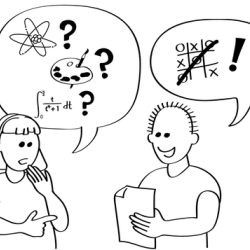Source Institutions
Source Institutions
Add to list Go to activity
Activity link broken? See if it's at the internet archive

This activity explores what it means for a computer to be intelligent and introduces the topic of what a computer program is and how everything computers do simply involves following instructions written by (creative) computer programmers. Learners interact with a piece of paper that contains rules for playing a perfect game of noughts-and-crosses (tic-tac-toe). The activity contains some thought provoking (and humorous) discussion questions. Explanation, variations, extensions, and resources are included in the PDF.
- Under 5 minutes
- 10 to 30 minutes
- free per group of students
- Ages 8 - adult
- Activity, Game, Lesson/Lesson Plan, Simulation
- English
Quick Guide
Materials List (per group of students)
- A whiteboard or flipchart
- 2 flip chart/whiteboard pens
- A copy of the intelligent piece of paper (possibly laminated) on page 6
- A Hallmark musical card that plays some appropriately horrible song recognizable by the age group (optional)
Subjects
-
Engineering and Technology
-
Computing
- Computer Science
- Information Systems
- Information Technology
-
Engineering
- Computer Engineering
-
Technology
- Information and Communication
-
Computing
-
Life Sciences
-
Human Body
- The Brain and Nervous System
-
Human Body
-
Mathematics
-
Data Analysis and Probability
- Probability
-
Data Analysis and Probability
-
The Nature of Technology
-
Technology and Society
- Impacts of Technology
-
Technology and Society
-
The Nature of Science
- Science as a Career
Informal Categories
- Computers
- Games
Audience
To use this activity, learners need to:
- see
- read
- touch
Learning styles supported:
- Involves hands-on or lab activities
Other
Foreign language versions of this resource:
Components that are part of this resource:
This resource is part of:
Access Rights:
- Free access
By:
- Curzon, Paul
Rights:
- Creative Commons: Non-commercial No Derivatives (by-nc-nd), Computer Science Unplugged,
Funding Sources:
- Brian Mason Scientific and Technical Trust
- Google Inc.
